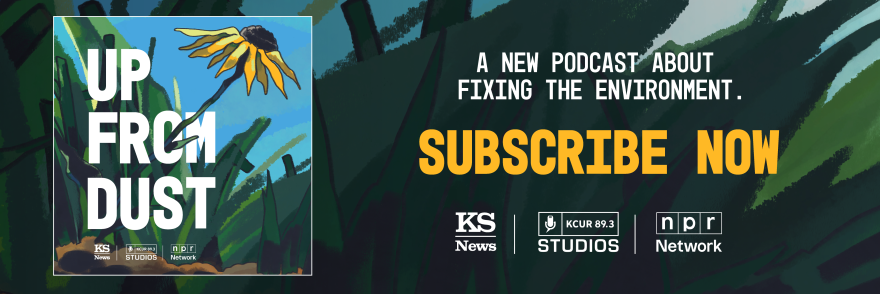This story was first published in KCUR's Adventure newsletter. You can sign up to receive stories like this in your inbox every Tuesday.
Climate change and other environmental crises fill more and more of us with anxiety, dread, gloom.
But even making a small difference can help keep the apocalyptic funk in check, public health experts say. For one thing, it reminds us that what we do matters.
Consider how many people delight in tending to native plants. It quickly brings bumblebees and butterflies back to the neighborhoods they abandoned, delighting the gardeners.
Learning to identify invasive species and eat them can provide a similar sense of satisfaction.
Picking a handful of invasive olive autumn berries won’t solve the world’s problems, but you get to snack — on something sweet and tangy — your way through lessons about what’s growing around you. And how various species do, or don’t, thrive together.
You may even become inspired to help local birds and butterflies by ripping out invasive shrubs to make room for the native plants their offspring need.
To learn what people in the Kansas City area are doing to control invasive species, check out the first episode of our new podcast, Up From Dust.
It’s a series all about the environmental price of trying to shape the world around humans, and how we can fix our generational mistakes. (Subscribe now wherever you get podcasts!)
Recently, we brought you a guide to planting native species at home, and the importance of gardening local.
Now, with some help from the Kansas Department of Wildlife and Parks, here are some tips for harvesting invasive species.
Fish fry… or fish fertilizer

Keep an eye out for the next white perch round-up and cookoff hosted by the wildlife department, likely later this spring at Lake Afton near Wichita. You can scale, gut and fry this tasty fish whole, without so much as fileting it.
White perch come from the eastern coastal states. It’s not clear how they started turning up in the middle of the country, but wildlife managers are so eager to suppress their numbers that you can take as many as you like.
The species swims in a dozen central Kansas lakes and waterways.
Not into eating invasive fish? Amy Bousman, a public educator at the Kansas Department of Wildlife and Parks has this tip: Bury them in your yard, put a rock on top, and let the soil benefit from this fertilizer.
If you don’t want them on your plate or in your lawn? Consider what Bousman did with leftover white perch people caught at last year’s competition.
“I took all of the little fish that weren’t used and donated them to a regenerative farm outside of Kansas City that had hogs,” she said. “And they absolutely loved them.”
Whatever you do, don’t throw the white perch back. Or take any of them to another lake or stream.
Garlic? Yum. Garlic mustard? Double yum.

Spring is a great time to scout for garlic mustard — before this tasty herb with its wallop of flavor gets too bitter.
The species likely arrived with European immigrants and has become a common find in Midwest fields and woods. You can clear a bit of space for other plants and make ecologists happy if you learn to harvest it.
Take along a trowel when you look for it, Bousman says, so you’ll be ready to dig this plant up.
Garlic mustard is related to mustard greens. So the taste hits you like a mix of garlic and horseradish. It’s good for salads and making chimichurri.
“In the spring, I make a wonderful pesto out of it,” Bousman says. “That one will get your sinuses moving!”
A BBQ with a tangy twist

Hungry for pie? Homemade jam? Or a fruity barbecue sauce? Scour the edges of woods for autumn olive bushes.
Autumn olive comes from Asia. Students at the University of Delaware studying hedgerows clogged with this and other invasive species found that 90% of caterpillars disappeared from those areas.
When insects suffer, so do birds. That’s one reason entomologist Douglas Tallamy recommends replacing invasive shrubs like autumn olive with native alternatives. (Here’s the Missouri Prairie Foundation’s Top 10 native shrubs for the lower Midwest)
Autumn olive berries start to ripen in early fall. Forage ripe berries early in their season for a tangy flavor, Bousman says. Or wait until late fall for sweeter, milder fruit.
“I make a barbecue sauce and serve that with wild rabbit,” Bousman says.
Ideally, you’ll want to kill the bush after picking its berries, she adds, but you’ll need permission from the landowner.
Carping about carp? Bread and fry them.

No carp are native to North America, but four species brought over in the 1970s create particular anxiety in the Midwest because they’re outcompeting other fish species and harming mussels.
They also have quite a reputation for leaping into people’s boats.
“You can totally eat it,” Bousman says. “Carp balls — which sounds like a funny name, but they’re breaded and fried and delicious.”
In Kansas, the state wildlife department doesn’t want these species around, so you’re welcome to fish as many as your heart desires. Like white perch, they also make great fertilizer.
The fish are popular fare on other continents, but Americans tend to turn up their noses because of the intramuscular bones. That’s unfortunate because the fish are overabundant and packed with nutrition.
If you like catfish, apparently you’ll love carp.





